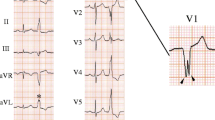Abstract
Arrhythmogenic right ventricular dysplasia (ARVD) is a structural heart disease affecting young adults that leads to cardiac rhythm disorders including supraventricular and mostly ventricular arrhythmias. Sudden death may be the first presentation of the disease. Ablation techniques have been used for the treatment of ventricular tachycardia in cases resistant to drug therapy. Radiofrequency is appropriate as a first approach for ventricular tachycardia ablation in ARVD; however, its effectiveness is less than 40% at the first session. Fulguration is effective for ventricular tachycardia ablation and should be used in the same session after ineffective radiofrequency ablation. However, fulguration requires expertise, general anesthesia, and more than one session in half of all patients.
Radiofrequency and fulguration plus other common forms of treatment including pacemakers and automatic implantable cardioverter defibrillators provides a clinical success rate of 81% to 93% in a series of 50 consecutive patients studied during 16 years. Earlier poor reputation of fulguration was the result of poorly understood technical problems concerning the physics and biophysics of the procedure under control with presently available methods. This in-depth study of a large population over a long time period demonstrates that fulguration should be rehabilitated.
Similar content being viewed by others
References and Recommended Reading
Fontaine G, Frank R, Gallais Y, et al.: Fulguration et radiofréquence dans la tachycardie ventriculaire. Arch Mal Coeur 1994, 87:1589–1607.
Haissaguerre M, Warin JF, Le Metayer P, et al.: Fulguration of ventricular tachycardia using high cumulative energy: results in thirty-one patients with a mean follow-up of twenty-seven months. PACE 1989, 12:245–251.
Kuck KH, Schluter M, Geiger M, et al.: Successful catheter ablation of human ventricular tachycardia with radiofrequency current guided by an endocardial map of the area of slow conduction. PACE 1991, 14:1060–1071.
Oeff M, Langberg J, Chin M, et al.: Ablation of ventricular tachycardia using multiple sequential transcatheter application of radiofrequency energy. PACE 1992, 15:1167–1176.
Borggrefe M, Willems S, Chen X, et al.: Catheter ablation of ventricular tachycardia using radiofrequency current. Hertz 1992, 17:171–178.
McKenna WJ, Thiene G, Nava A, et al.: Diagnosis of arrhythmogenic right ventricular dysplasia / cardiomyopathy. Br Heart J 1994, 71:215–218.
Tonet J, Himbert C, Johnson N, et al.: Prolongation of ventricular refractoriness and ventricular tachycardia cycle length by the combination of oral beta-blocker-amiodarone in patients with Ventricular Tachycardia. PACE 2000, 23(Part II):565. Demonstration of the benefit of Amiodarone in combination with b-blocking agents. However this combination may lead in 15% of cases to dynamic drug to drug interaction necessitating rate support pacemaker implantation.
Langberg J, Lee MA, Chin M et al.: Radiofrequency catheter ablation: the effect of electrode size on lesion volume invivo. PACE 1990, 13:1242–1248.
Fontaine G, Cansell A, Lampe L, et al.: Endocavitary fulguration (electrode catheter ablation): equipment-related problems. In Ablation in Cardiac Arrhythmias. Edited by G Fontaine, MM Scheiman. Mount Kisko: Futura; 1987:85–100.
Gallais Y, Lascault G, Tonet J, et al.: Continuous measurement of coronary sinus oxygen saturation during ventricular tachycardia [Abstract]. Eur Heart J 1993, 14(supp.): 368.
Morady F, Frank R, Kou WH, et al.: Identification and catheter ablation of a zone of slow conduction in the reentry circuit of ventricular tachycardias in humans. J Am Coll Cardiol 1988, 11:775–782.
Fontaine G, Frank R, Tonet J, et al.: Identification of a zone of slow conduction appropriate for VT ablation: theoreticaland practical considerations. PACE 1989, 12(Part II):262- 267.
Stevenson WG, Khan H, Sager P, et al.: Identification of reentry circuit sites during catheter mapping and radiofrequency ablation of ventricular tachycardia late after myocardial infarction. Circulation 1993, 88:1647–1670.
Man KC, Daoud E, Knight BP, et al.: Accuracy of the unipolar electrogram for identification of the site of origin of ventricular activation. J Cardiovasc Electrophysiology 1997, 8:974–979.
Harada T, Aonuma K, Yamauchi S, et al.: Catheter ablation of ventricular tachycardia in patients with right ventricular dysplasia: identification of target sites by entrainment mapping techniques. PACE 1998, 21:2547–2550.
Vedel J, Frank R, Fontaine G, et al.: Bloc auriculo-ventriculaire intra-hisien definitif induit au cours d'une exploration endoventriculaire droite. Arch Mal Coeur 1979, 72:107–112.
Scheinman MM, Morady F, Hess DS, et al.: Catheter-induced ablation of the atrioventricular junction to control refractory supraventricular arrhythmias. JAMA 1982, 248:851–855.
Gallagher JJ, Svenson RH, Kasell JH, et al.: Catheter technique for closed-chest ablation of the atrioventricular conduction system. N Engl J Med 1982, 306:194–200.
Hartzler GO: Electrode catherter ablation of refractory focal ventricular tachycardia. J Am Coll Cardiol 1983, 2:1107–1113.
Puech P, Gallay P, Grolleau R, et al.: Traitement par electrofulguration endocavitaire d'une tachycardie ventriculaire recidivante par dysplasie ventriculaire droite. Arch Mal Coeur 1984, 77:826–835.
Fontaine G, Tonet JL, Frank R, et al.: Traitement d'urgence de la tachycardie ventriculaire chronique apres infarctus du myocarde par la fulguration endocavitaire. Arch Mal Coeur 1985, 78:1037–1043.
Feld GK: Expanding Indications for radiofrequency catheter ablation: ventricular tachycardia in association with right ventricular dysplasia. J Am Coll Cardiol 1998, 32:729–731.
Wichter T, Hindricks G, Kottkamp H, et al.: Catheter ablation of ventricular tachycardia. In Arrhythmogenic Right Ventricular Cardiomyopathy/Dysplasia. Edited by Nava A, Rossi L, Thiene G. Amsterdam: Elsevier Science; 1997:376–391.
Stevenson WG, Delacretaz E, Friedman PL, et al.: Identification and ablation of macro-reentrant ventricular tachycardia with the CARTO electroanatomical mapping system. PACE 1998, 21:1448–1456. Description of a new promising technique for proper localization of catheter inside the heart for VT ablation.
Author information
Authors and Affiliations
Rights and permissions
About this article
Cite this article
Fontaine, G., Tonet, J., Gallais, Y. et al. Ventricular tachycardia catheter ablation in arrhythmogenic right ventricular dysplasia: A 16-year experience. Curr Cardiol Rep 2, 498–506 (2000). https://doi.org/10.1007/s11886-000-0034-1
Issue Date:
DOI: https://doi.org/10.1007/s11886-000-0034-1




